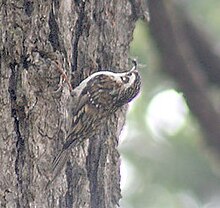
The Siberian stonechat or Asian stonechat is a recently validated species of the Old World flycatcher family (Muscicapidae). Like the other thrush-like flycatchers, it was often placed in the Turdidae in the past. It breeds in the East Palearctic including in easternmost Europe and winters in the Old World tropics.

The nuthatches constitute a genus, Sitta, of small passerine birds belonging to the family Sittidae. Characterised by large heads, short tails, and powerful bills and feet, nuthatches advertise their territory using loud, simple songs. Most species exhibit grey or bluish upperparts and a black eye stripe.
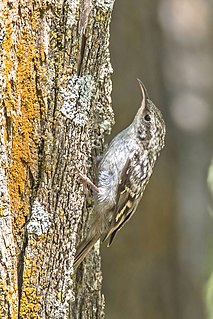
The treecreepers are a family, Certhiidae, of small passerine birds, widespread in wooded regions of the Northern Hemisphere and sub-Saharan Africa. The family contains eleven species in two genera, Certhia and Salpornis. Their plumage is dull-coloured, and as their name implies, they climb over the surface of trees in search of food.

The Indian spotted creeper is a small passerine bird, which is a member of the subfamily Salpornithinae which is placed along with the treecreepers in the family Certhiidae. This small bird has a marbled black and white plumage that makes it difficult to spot as it forages on the trunks of dark, deeply fissured trees where it picks out insect prey using its curved bill. It is found in patchily distributed localities mainly in the dry scrub and open deciduous forests of northern and central peninsular India. It does not migrate. Their inclusion along with the treecreepers is not certain and some studies find them more closely related to the nuthatches while others suggest a close relation to the wallcreeper. They lack the stiff tail feathers of treecreepers and do not use their tail for supporting them while creeping vertically along tree trunks.

The yellow-browed warbler is a leaf warbler which breeds in the east Palearctic. This warbler is strongly migratory and winters mainly in tropical South Asia and South-east Asia, but also in small numbers in western Europe. Like the rest of Phylloscopidae, it was formerly included in the Old World warbler assemblage.
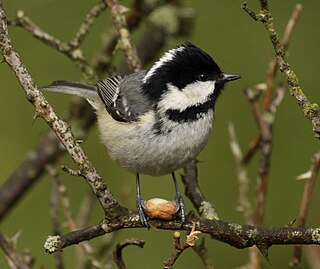
The coal tit or cole tit,, is a small passerine bird in the tit family, Paridae. It is a widespread and common resident breeder in forests throughout the temperate to subtropical Palearctic, including North Africa. The black-crested tit is now usually included in this species.

The Eurasian treecreeper or common treecreeper is a small passerine bird also known in the British Isles, where it is the only living member of its genus, simply as treecreeper. It is similar to other treecreepers, and has a curved bill, patterned brown upperparts, whitish underparts, and long stiff tail feathers which help it creep up tree trunks. It can be most easily distinguished from the similar short-toed treecreeper, which shares much of its European range, by its different song.
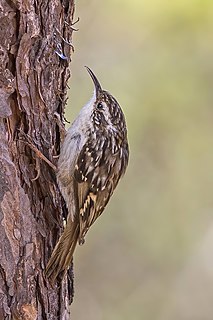
The short-toed treecreeper is a small passerine bird found in woodlands through much of the warmer regions of Europe and into north Africa. It has a generally more southerly distribution than the other European treecreeper species, the common treecreeper, with which it is easily confused where they both occur. The short-toed treecreeper tends to prefer deciduous trees and lower altitudes than its relative in these overlap areas. Although mainly sedentary, vagrants have occurred outside the breeding range.

Hume's leaf warbler or Hume's warbler is a small leaf warbler which breeds in the mountains of inner Asia. This warbler is migratory and winters mainly in India.

The Himalayan black-lored tit, also known as simply black-lored tit, is a passerine bird in the tit family Paridae. The yellow-cheeked tit is probably its closest relative, and it may also be related to the yellow tit. These three tits almost certainly form a distinct lineage, as indicated by morphology, and mtDNA cytochrome b sequence analysis.
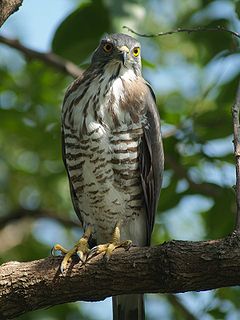
The crested goshawk is a bird of prey from tropical Asia. It is related to other diurnal raptors such as eagles, buzzards and harriers, and thus placed in the family Accipitridae.

Certhia is the genus of birds containing the typical treecreepers, which together with the African and Indian spotted creepers make up the family Certhiidae.
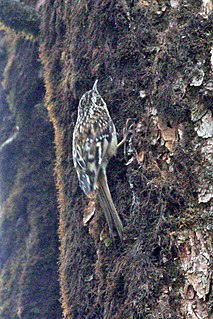
The Sichuan treecreeper is a rare species of bird in the treecreeper family, Certhiidae.

Hodgson's frogmouth is a species of bird in the family Podargidae. It is found in Bangladesh, Bhutan, China, India, Laos, Myanmar, Thailand, and Vietnam. Its natural habitat is temperate forests.

The Sikkim treecreeper is a species of bird in the treecreeper family.

The rufous-vented tit is an Asian songbird species in the tit and chickadee family (Paridae). Some of its subspecies were formerly assigned to its western relative the rufous-naped tit, or these two were considered entirely conspecific.

Hume's treecreeper was earlier included within the brown-throated treecreeper complex and identified as a separate species on the basis of their distinctive calls. This species in the treecreeper family is found in Assam, Myanmar, Shan Mountains, Northern Thailand, Laos and the Dalat Plateau.

The Himalayan cutia is a bird species in the family Leiothrichidae. Its scientific name ultimately means "the khutya from Nepal", as Cutia is derived from the Nepali name for these birds, and nipalensis is Latin for "from Nepal".

The Indian black-lored tit, Indian tit, or Indian yellow tit is a passerine bird in the tit family Paridae. The yellow-cheeked tit is probably its closest relative, and both may be related to the yellow tit. These three tits almost certainly form a distinct lineage as evidenced by morphology, and mtDNA cytochrome b sequence analysis. The subgenus name Macholophus may apply for them.
